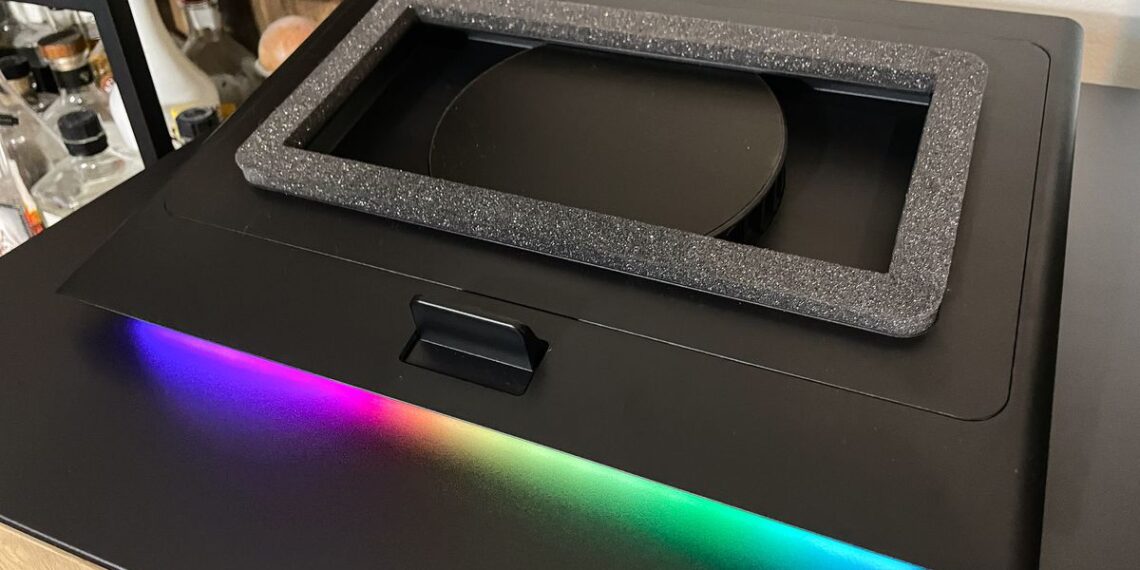Keeping your laptop cool while gaming doesn’t just improve its performance; it also prolongs the life of its components and helps avoid battery bloat, an affliction that becomes more common with age. Razer says its $150 Laptop Cooling Pad works with laptops of any size and will lower CPU and GPU temperatures by up to 18 percent. (It also, naturally, has an RGB strip.)
With some Razer gaming laptops, it can go even further. When the cooling pad is connected via USB to a 2023 or 2024 Razer Blade 16, a feature called Hyperboost automatically adjusts fan speed and cooling mode and lets the laptop allocate up to 20 extra watts each to the CPU and GPU. (Razer is bringing Hyperboost to more models over the coming months.)
I’ve played around with the Razer Laptop Cooling Pad for the last few weeks, both before and after the Hyperboost update. And while it isn’t quite as impressive as Razer claims, I did notice a significant improvement in 1080p performance in games that were previously held back by a lack of power to the CPU.
I tested the Razer Laptop Cooling Pad with a top-of-the-line 2024 Razer Blade 16 with a mobile Nvidia RTX 4090 graphics card and Intel Core i9-14900HX CPU, as well as with the 2024 Asus ROG Zephyrus G16 (AMD version). It’s possible to cycle through preset fan speeds and RGB lighting configurations using buttons on the side, but fine control requires installing Razer Synapse, which might be a deal-breaker for some people even if the price isn’t.
Let’s address the elephant in the room first: Razer’s cooling pad gets loud. With the 140mm fan spinning full bore, I measured 62 decibels right next to the laptop and about 56 to 58 decibels in what I would consider a realistic gaming position. (My apartment has a noise floor of about 40 decibels.) It’s not ear-splitting, but the fan’s constant volume and mechanical timbre are distracting — it sounds close enough to a vacuum cleaner to startle my cat. For comparison, the built-in fans on both laptops I tested output at less than 50 decibels using their Turbo power profiles.
Razer’s quest to create a laptop cooling pad that can fit any device also means that it’s large by necessity. Not only does it take up more space on the desk than your laptop alone but it also requires external power and uses a bulky adapter that crowds out the plug next to it on the power strip. It comes with three different top plates that snap to the pad magnetically. The plate for laptops from 14 to 16 inches and the one for 18-inch laptops use memory foam strips to create an airtight seal between the fan chamber and the intake vents at the bottom of the laptop. The third, for fanless or ventless devices like the MacBook Air, is totally flat. The back boasts three USB-A 2.0 ports that remain accessible no matter the size of the laptop on top.
It’s a good thing that Hyperboost works, at least in certain circumstances. In his review of the 2024 Razer Blade 16, YouTuber Jarrod’sTech noted that both it and the 2023 model underperform at 1080p. That’s because, by default, they allocate more of their total power allowance to the GPU, but at lower resolutions, most games are held back by the CPU.
Hyperboost blows past that. With more power to the CPU, the 2024 Blade 16 put out 123 frames per second in Cyberpunk 2077 at 1080p with every setting maxed out (except ray tracing), compared to the 90fps I measured without Hyperboost. Shadow of the Tomb Raider was similar: at 1080p max settings, I measured 204fps with Hyperboost on and 185 with it disabled.
Once you leave 1080p, the advantage evaporates
Once you leave 1080p, the advantage evaporates; the GPU becomes the limiting factor, and pumping more power into it grants diminishing returns. At the Blade 16’s native 1600p resolution (and above, if you’re using an external monitor), I measured about the same frame rate with or without Hyperboost, give or take a frame or two. Temperatures are still noticeably lower, with the power-hungry Intel Core i9-14900HX staying below 90 degrees Celsius and the RTX 4090 keeping under 70 degrees under torture testing, but the 2024 Blade 16 already had a great cooling system thanks to its thickness. Thermal throttling was never a concern.
The Razer Laptop Cooling Pad will do a good job of cooling non-Razer gaming laptops, too — with or without Synapse. It prevented the AMD Ryzen AI 9 HX 370 processor inside the Asus ROG Zephyrus G16 from reaching its 95 degrees Celsius ceiling when benchmarking, which it usually hits quite fast. Even the strip above the keyboard, which often hits 115 degrees Fahrenheit, topped out at a comparatively balmy 90 degrees under full load.
Unfortunately, I couldn’t get a statistically significant frame rate improvement in games or synthetic tests on the ROG Zephyrus G16 — even after taking advantage of the thermal headroom to overclock the CPU and GPU.
Therein lies the biggest problem with the Razer Laptop Cooling Pad. It certainly pushes air around, but only people with a Hyperboost-compatible Razer Blade 16 — a very small segment of the overall gaming population — will see a difference in performance, and even then, only in CPU-limited games.
Of course, it’s possible that Hyperboost will make more of a difference in other Razer laptops, like the slimmer Blade 16 that Razer announced at CES the same day it released Hyperboost. The new Blade is about as thick as the ROG Zephyrus G16, which uses drastic power and temperature limits to keep heat under control in its slim chassis. Maybe the new Blade 16 will manage the heat just fine, like the 2024 model, but perhaps the timing isn’t entirely coincidental.
Finally, as Reddit users have pointed out, Razer’s $150 cooling pad has a lot in common with similar cooling stands from Llano or IETS: all require external power, use an adjustable-speed 140mm fan, have RGB and a USB hub, and seal to the laptop with memory foam, but the Llano and IETS coolers cost closer to $100. Many of them even have adjustable tilt levels, which the Razer cooling pad lacks. We haven’t tested them, but unless you have a compatible Razer Blade or really want the RGB lights on your laptop cooling pad to sync with Chroma, something more basic will work just as well for $50 less.
Photography by Jonathan Hilburg for The Verge.
Read the full article here








